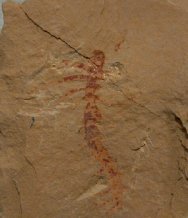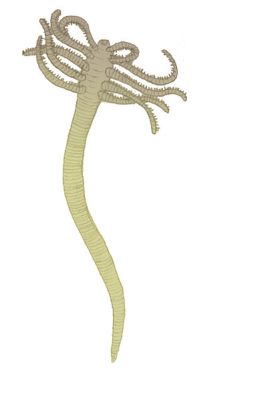| Panarthropoda | ||
| Ecdysozoa | Luolishaniidae |
| Hallucigeniidae | Ecdysozoa | Panarthropoda
└─► |
Siberiidae | |
| Nematoida | None |
Tardigrada |
|
Abbreviated Dendrogram
Ecdysozoa
╞═Scalidophora
└─┬─Nematoida
│
└─Panarthropoda
├─Aysheaia
└─┬─Tardigrada
└─┬─Xenusiidae
├─Onychophora
└─┬─Archonychophora
│ ├─Hallucigenia
│ └─Luolishaniidae
│ ├─Luolishania
│ └─Facivermis
╘═╤═Siberiidae
╘═╤═Dinocaridida
└─Arthropoda
|
Contents
Overview |

Luolishaniidae Hou & Bergström, 1995
Early to Mid Cambrian of China & Nth Am.
Phylogeny: Archonychophora : Cardiodictyon + (Hallucigenia + (Onychodictyon + * : Luolishania + Facivermis))
Comments: Filter feeders close to the protoarthopods. Here used to include Luolishania (Miraluolishania is probably a synonym) and the unnamed Burgess Shale lobopodian called Collins' monster (perhaps another species of Luolishania?), which appear together on several phylogenetic analyses (Ma et al 2009, Liu et al 2011) and the bizarre Facivermis, here interpreted as a highly specialised secondarilty partly limbless lobopodian (Dzik 2011) rather than a transitional priapulozoan-panarthropod. According to Ma et al 2009 the Luolishaniids are specialised (crown group using the term in a non-neontological sense) Archonychophora, although Luolishania displays arthropod-like antennae and compound eyes which imply the group may be more derived (closer to true arthropods) than related taxa such as Hallucigenia. MAK120430
Illustration: Luolishania longicruris (= Miraluolishania haikouensis), life recosntruction from Ma et al 2009

Luolishania longicruris Hou & Chen 1989
Synonym: Miraluolishania haikouensis Liu et al., 2004
Horizon: Qiongzhusi Formation, Maotianshan Shales, Chengjiang Lagerstätte, Yunnan, South China, (Atdabanian age - Early Cambrian)
Phylogeny: Luolishaniidae : Facivermis + *
Comments: Previously considered a standard long-limbed lobopodian, this taxon has jumped around the phylogenetic tree quite markedly, as a glance at the cladograms reveals. Hou & Bergström 1995 considered that Luoishania is the sister taxon to all other fossil and recent onychophorans. Ramsköld & Chen 1998 in the first cladistic analysis of the group placed it next to Xenusion. Eriksson et al 2003 considered Luolishania to occupy an inrtermediate position above extant onychophores but below all other fossil forms other than the basal taxon Aysheaia. Liu et al 2008 p.280 Luolishania as a generalised form, without specialized head structures, whereas Miraluolishania is much more derived, with pairs of eyes and antennae on the head and the trunk showing primitive tagmosis. But a study by Ma et al 2009 using newly discovered Luolishania material, shows the same advanced arthropod like features, and show Miraluolishania to be a junior synonym. They place Luolishania in the newly defined clade Archonychophora as sister taxon to protoarthropods and arthropods.. Liu et al 2011 reject this interpretation and restore Miraluolishania, which now becomes the sister taxon to the Crown group Onychophora. But in view of the reported arthropod-like features of (Mira)Luolishania we have chosen to place the We have followe Ma et al (2009)'s interpretation here.
Luolishania (= Miraluolishania) is thus a transitional form, possessing a mosaic of both lobopodian and arthropod characters. Its lobopodian features are worm-like body design, dorsal spines, differentiated sclerites, lobopod interspaces and non-segmented limbs or lobe-like legs with standard lobopod claws. Arthropod features include primary cephalization with paired eyes, paired antennae (or antenniform-like outgrowths), setae and other cuticular projections, and incipient tagmosis and head shield. (Cambrian lobopods, Ma et al 2009). Although the holotype of Luolishania seems to show three or more claws per limbs, all specimens identified as Miraluolishania unquestionably show two claws terminally per limb (Liu et al 2011). As with the related Collins' monster, and Diania (which may or may not belong in this clade) the trunk divided into two sections (bipartite) ( Ma et al 2009, Liu et al 2011).
Evidence from gut filling and specialized morphological characters indicates that Luoishania may have been a filter feeder (Ma et al 2009).
More: Luolishania longicruris, Virtual Fossil Museum

Facivermis yunnanicus Hou & Chen, 1989
Horizon: Qiongzhusi Formation, Maotianshan Shales, Chengjiang Lagerstätte, Yunnan, South China, (Atdabanian age - Early Cambrian)
Phylogeny: Luolishaniidae : Luolishania + *
Comments: For a long time a problematic form, due to poorly preserved specimens, appearing to be a worm-like fossil with five pairs of tentacles and a perceived shrunken end. Facivermis has been variously been regarded as related to polychaete annelids, lobopodians, pentastoma and lophophorates. Newly discovered complete specimens show that the apparent tentacles are in fact five pairs of standard lobopods, most resembling the appendages of the fore-trunk of lobopodian Miraluolishania (= Luolishania). The rest of the body is divided into a slender region devoid of appendages and a pear-shaped posterior bearing two or three circles of hooks. As with Hallucinogenia, Facivermis is another Cambrain species that turns out to be more understandable on further examination. Which is not to say that all the problems have been cleared up. Although clearly a transitional form of some sort, the question remains whether Facivermis is a priapulozoan worm becoming a lobopodian, or a lobopodian secondarily becoming a worm (Zhuravlev et al 2011), or for that matter a pentastomatid. On the one hand, Facivermis shows features consistent with the transition from priapulid-style burrowing and lobopodian-style creeping on the seafloor (Liu et al 2006, 2008 also cited in Edgecombe 2009). Studies of molecular and development biology indicate that the first five to seven segments seem to be important in development of the arthropod condition, with appendages begining in the cephalon area, and trunk appendages controlled by the budding zone. The Late Cambrian Orsten (3-dimensionally preserved microfossil) crustaceans suggest that the anterior five to seven limbs- bearing segments develope into the cephalon of the euarthropods Liu et al 2006
Yet Facivermis does not resemble a primitive lobopodian like Aysheaia, but a more highly derived one like Luolishania. Add to the fact that Luolishania seems to have been a sedentary filter feeder Ma et al 2009 it is quite likely that Facivermis was a simialr but even more specialised form (Dzik 2011),, in which case the original annelid and lophorphorate filter feeding hypotheses may not have been that far fetched after all. Rather than beinga trabnsitional priapulozoan (whether worm to lobopodian or lobopodian to worm) Facivermis seems to have represnted a unique development in Cambrian evolution, illustrating again the great ecological and morphological diversity of the ecdysozoa during this time MAK120424
Reference Liu et al 2006
Illustration: Life reconstruction of Facivermis yunnanicus, artwork by Ghedoghedo Wikipedia, Creative Commons Attribution-Share Alike/GNU Free Documentation License.
| Hallucigeniidae | Siberiidae |
page MAK120424. All text content by M. Alan Kazlev is Creative Commons Attribution . Other content copyright respective authors or publishers